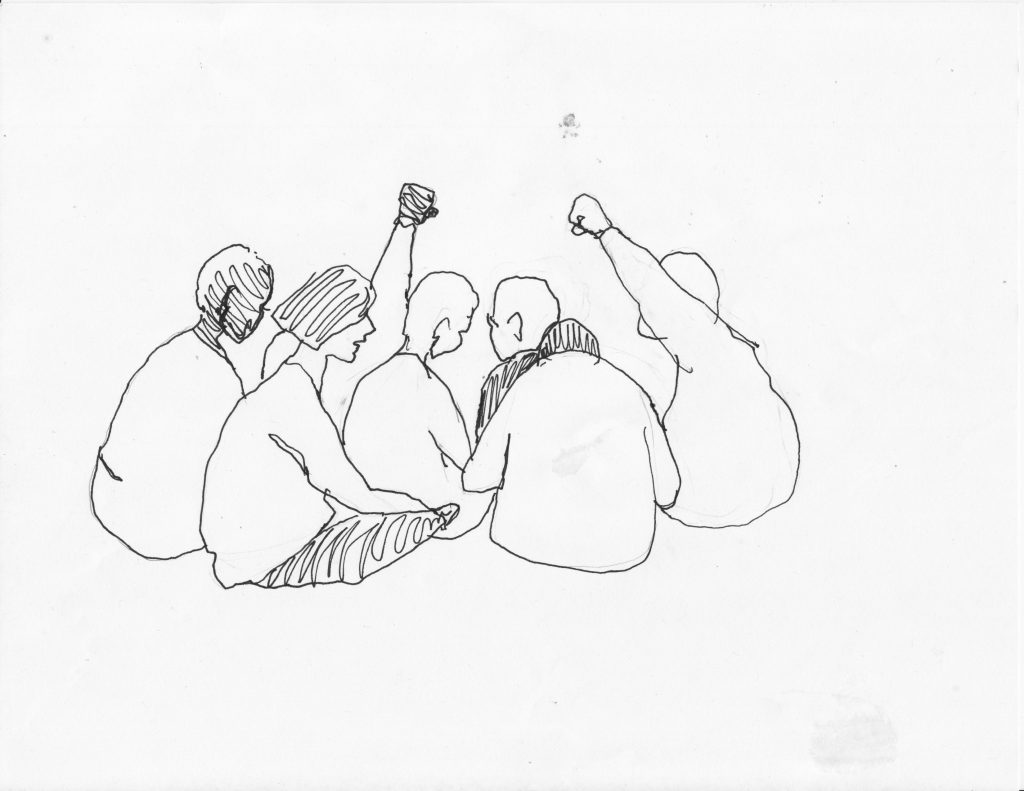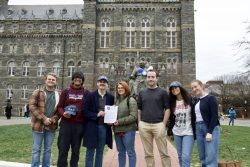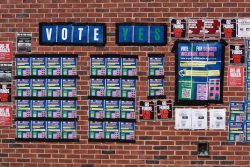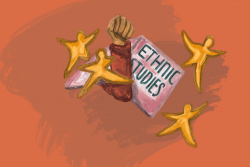University protests on race relations across the U.S. have provoked a flurry of media attention and political activism in recent weeks. This Editorial Board fully and adamantly supports efforts to address this difficult issue, but takes exception to some aspects of the process.
The Hoyas who’ve coalesced around the “BuiltOn272” and “GU272” hashtags have, on the whole, set a excellent example of student activism, and this Editorial Board cheers the success they’ve had in cultivating a conversation about injustices in Georgetown’s past and its present. The Hilltop—and the nation at large—must reckon with a living legacy of institutional racism, and student activists here deserve praise for kickstarting that reckoning. We have them, along with those who’ve raised their voices at Mizzou and other schools, to thank for the important dialogues and remedies to come. It must also be said, though, that Georgetown’s administrators, particularly President DeGioia, merit recognition for their respect for student viewpoints. In creating the Working Group on Slavery, Memory, and Reconciliation, the university made a good-faith effort to tackle latent issues of race and racism on campus, and when the time came for change, it acted. We wish the same could be said of other universities.
It’s encouraging to see free speech functioning well on the Hilltop, at least by the lower standard set by Georgetown’s often questionable track record. Hoyas faced no restrictions on their expression across campus, from Red Square to President DeGioia’s office. We worry, though, that some of the rhetoric espoused by student activists on social media and in person has had a chilling effect on the First Amendment right (and responsibility) of the press to report, in addition to the basic rights of other Hoyas to disagree with their cause.
In the Facebook event page used to organize the Red Square demonstration and subsequent sit-in in President DeGioia’s office, a succession of posts urged attendees not to speak to any press, citing a need for the action “to be safe and narrated in a certain way.” While we understand and sympathize with this impulse, and respect students’ right to refuse to speak with whomever they so choose, we find it problematic. In a thoughtful Washington Post opinion piece, freelance journalist Terrell Starr speaks of a tendency in the media to focus on less savory episodes in protest movements such as Black Lives Matter, implicitly “criminaliz[ing] black people’s pain and resistance to racial oppression.” It is this tendency—which doubtlessly exists—which drove some Hoyas to urge fellow demonstrators to turn away from the media. Starr’s lesson, though, cannot be that the media must steer clear of race-related protests or that protesters must stay away from the media. Rather, it is a call for balance and sensitivity that all press, including this newsmagazine, must heed.
The first two principles of the Society of Professional Journalists’ Code of Ethics are “seek the truth and report it” and “minimize harm.” These mandates are clearly and inexorably in conflict. In the case of campus conversations on race—just as in every case—a balance must be struck between these principles. On some level, this means that reporters must report. It’s more than their job; it’s a service to the public’s vested right to know what’s going on in the world. Students are, again, well within their rights in refusing to talk to reporters, but doing so repudiates not just the vital public interest but also the interest of all activists in ensuring their side of the story is heard.
The Editorial Board was also troubled by the vitriol some student activists directed at those who challenged them or otherwise did not support their actions. It’s true: student activists do not have to ask nicely in combatting racism, and, moreover, the palpable anger, pain, and sorrow felt by Hoyas of color must find expression. With that being said, Hoyas should not be too quick to paint their peers with the scarlet letter of “white fragility”—which indirectly alleges racism—the moment their opinions diverge. Doing so is unfair, and serves only to alienate at a time when reconciliation is needed. And yes, it is this same unfairness that Americans of color have been made to face for centuries, but the experience of oppression does not legitimize the creation of a cycle of social estrangement.
On college campuses throughout the country, students are working to combat negative racial climates. The issue is that racial climate is intangible. This has lead the recent university movements to approach an intangible issue with demands for tangible change—a difficult task indeed. And so, it is hard to discern which actions will allow the community to take a step forward, which actions are ineffective, and which actions are counterproductive.
At Yale and at Claremont McKenna, movements with the stated goal of creating a climate of equality and acceptance pursued actions that had exactly the opposite effect. After perceiving actions of administrators as symptoms of a racist climate, protesters called for their resignation—rather than publicly question these administrators to better diagnose the issues at hand. Certain protesters used phrases like “silence is violence” to vilify all who disagreed with them. At Missouri, photographer Tim Tai, an Asian-American student aiming to document protests, encountered both verbal and physical abuse from protesting students and faculty. When there is no room for discourse, when administrators who fall under fire are expected to silently resign, when those who agree with the goal but disagree with the methods of a movement must stay silent for fear of being branded a heretic, our community does not move forward. Accusations of moral failure, whether it be through verbal attacks or forced resignations, create a dynamic of opposition and divert us, as a community, from our intended ends.
At Missouri, President Tim Wolfe resigned after protests reached a critical mass. Whether or not Wolfe was guilty of perpetuating a climate of racism, he likely did not resign because he realized his failings, but because of financial pressures induced by the football team’s boycott (an estimated $1 million loss per game not played) and urgings from members of the university’s board. Though the protesters forced Wolfe’s resignation, one does not need to look far to see that the larger problem of intolerance is still rampant at Missouri. Dean Mary Spellman’s resignation at Claremont McKenna does not solve any of the university’s issues. Driving a wedge between students and administrators only creates animosity within our communities, making the healing process to come that much harder. By enumerating tangible steps for improvement, as the #BuiltOn272 movement has at Georgetown, and allowing for discussion from throughout the community, universities can begin to move toward better futures.
At Georgetown, we believe that all students, staff, and faculty should be united behind the goal of creating an environment where everybody feels comfortable. But, when members of the Georgetown community feel uncomfortable voicing their views, the school will always be divided. As seen most acutely with the Yale email on Halloween costumes, if differing opinions—or even just the questioning of others’ opinions—get immediately discredited, we as a community will fail. Rather, we must listen to each other in order to tackle the issues at hand.
In arguably his most famous piece in The Atlantic, “The Case for Reparations,” Ta-Nehisi Coates advocates for the passing of a bill called H.R. 40, the Commission to Study Reparation Proposals for African-Americans Act. This bill alone is not the solution to the issue of racism in this country, but through creating the open discussion and critique of courses of action, it is meant to be a first step toward creating equality. There will be disagreements about how to create an equal campus, and an equal society, but the best way to get past them, at Georgetown and beyond, is to continually discuss these issues with the intention, not of silencing others, but understanding them.
When it comes to equality, there is no “them.” There is only us, trying to make a better future for everybody.






